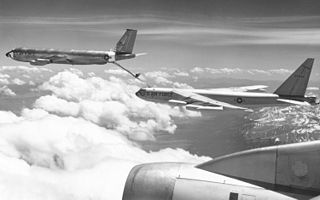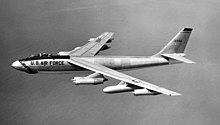
The 11th Wing is a United States Air Force unit assigned to the Air Force District of Washington. It is the host unit at Joint Base Anacostia-Bolling in Washington, D.C., on from June 2020. It previously was stationed at Joint Base Andrews, Maryland where it was the host unit. The 11th Wing was one of the largest wings in the Air Force. It is known as "The Chief's Own", an honorific originally intended to reflect that the Chief of Staff of the United States Air Force personally created the organization.

The 499th Air Refueling Wing is an inactive United States Air Force (USAF) unit that was last active at Westover AFB, Massachusetts in June 1966.

The 320th Air Expeditionary Wing is a provisional United States Air Force unit assigned to the Air Force District of Washington. It is stationed at Bolling AFB, District of Columbia. The 320 AEW may be activated or inactivated at any time.

The 484th Air Expeditionary Wing is a provisional United States Air Force unit assigned to Air Combat Command. It may be activated or inactivated at any time. It was activated and attached to United States Air Forces Central for the invasion of Iraq in 2003. It was headquartered at Prince Sultan Air Base, Saudi Arabia.

The 449th Air Expeditionary Group is a provisional United States Air Force unit assigned to the Third Air Force supporting United States Africa Command. It is stationed at Camp Lemonnier, Djibouti. It flies missions for Africa Command and Combined Joint Task Force – Horn of Africa, supporting varied U.S. objectives in the area.

The 416th Air Expeditionary Wing (AEW) is a provisional unit assigned to the Air Combat Command of the United States Air Force to activate or inactivate as needed.

The 500th Air Expeditionary Group is a provisional United States Air Force unit. Its last known assignment was at Christchurch, New Zealand, where it was activated for the summer 2005–2006 season.

The 462d Air Expeditionary Group is a provisional unit of the United States Air Force. It is assigned to Air Mobility Command to activate or inactivate as needed to meet operational requirements. Its last assignment was at Naval Support Facility Diego Garcia, British Indian Ocean Territory.

The 453rd Bombardment Group is an inactive United States Air Force unit that was first organized in June 1943, during World War II, as a Consolidated B-24 Liberator heavy bomber group. After training in the United States, it deployed to England in December 1943, and, starting in February 1944, participated in the strategic bombing campaign against Germany with Eighth Air Force. Its 733d Bombardment Squadron completed 82 consecutive missions without a loss, a record for Eighth Air Force bomber units. James Stewart, of film fame, was group operations officer from 31 March to 1 July 1944. The group was programmed for redeployment to the Pacific and returned to the United States in May 1945 for training, however the Japanese surrender cancelled these plans and the group was inactivated in September 1945.

The 494th Air Expeditionary Group is a provisional United States Air Force group assigned to Air Mobility Command (AMC) to activate or inactivate as needed. The group was activated in the events surrounding Operation Iraqi Freedom, the 2003 United States invasion of Iraq. Now-Lieutenant General Stayce D. Harris is listed by the USAF as commanding the 494th AEG at Moron Air Base, Spain, from July to October 2003. In addition, a patch published at USAF Patches.com implies that the group was active in Spain during "Iraqi Freedom."

The 2nd Air Refueling Squadron, sometimes written as 2d Air Refueling Squadron, is a unit of the United States Air Force. It is part of the 305th Air Mobility Wing at McGuire Air Force Base, part of Joint Base McGuire-Dix-Lakehurst, New Jersey. The 2nd Air Refueling Squadron is the second-oldest squadron in the Air Force, having over 100 years of service to the nation. It was deployed to the Philippines after World War I, during the 1941-1942 Battle of the Philippines, it was wiped out, with the Japanese forcing some of the personnel to endure the Bataan Death March. It was re-formed as an air refueling squadron by Strategic Air Command in 1949. Today, it operates the KC-46 Pegasus aircraft, conducting aerial refueling missions.

The 911th Air Refueling Squadron is part of the 305th Operations Group, and is stationed at Seymour Johnson Air Force Base, North Carolina. The squadron was the Air Force's very first active duty squadron under the command of a reserve wing. In October 2016, the 911th, formerly geographically separated from the 6th Air Mobility Wing at MacDill Air Force Base, Florida and operated as the active duty associate to the 916th Air Refueling Wing, became the first "I-Wing" or Integrated Wing. In July 2020, it was reassigned to the 305th Operations Group at the McGuire AFB entity of Joint Base McGuire–Dix–Lakehurst, New Jersey.

The 22d Expeditionary Air Refueling Squadron is a provisional United States Air Force unit, assigned to Air Mobility Command. It is engaged in combat operations as part of the Global War on Terrorism in Afghanistan. Its current status and location are undetermined. The squadron's permanent designation is the 22d Air Refueling Squadron.

The 28th Operations Group is the flying component of the United States Air Force 28th Bomb Wing, stationed at Ellsworth Air Force Base, South Dakota.

The 98th Air Refueling Squadron is an inactive United States Air Force unit. Its last assignment was with the 92d Operations Group at Fairchild Air Force Base, Washington, where it was inactivated on 1 July 1998.

The 28th Expeditionary Air Refueling Squadron is a provisional United States Air Force unit. It was last known to be assigned to the 40th Air Expeditionary Group. Diego Garcia Air Base, British Indian Ocean Territory. Its current status is at Al Udeid Air Base under the 379th Expeditionary Operations Group.

The 310th Expeditionary Air Refueling Flight is a provisional United States Air Force unit. The flight was last active as the 310th Air Refueling Squadron in October 1994, when it was assigned to the 380th Air Refueling Wing at Plattsburgh Air Force Base.

The 904th Expeditionary Air Refueling Squadron is an inactive United States Air Force unit. It was last assigned to the 320th Bombardment Wing at Mather Air Force Base, California, where it was inactivated on 30 September 1986.

The first predecessor of the 914th Expeditionary Air Refueling Squadron was organized in 1942 as the 8th Observation Squadron. It trained in the United States during World War II as a reconnaissance unit and then provided target support for antiaircraft units until being disbanded in 1944 during a general reorganization of Army Air Forces units in the United States. It was reactivated and deployed to the South West Pacific Theater of World War II and was inactivated in the Philippines in February 1946.

The 928th Expeditionary Air Refueling Squadron is a provisional unit of the United States Air Force. It is assigned to Air Mobility Command to activate or inactivate as needed for contingency operations.































